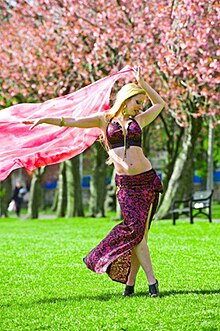Belly Dance ?
For your information, the origin of the name "belly dance" comes from the French Danse du ventre that means "dance of the stomach" and it is a type of Middle Eastern dance. It have two distinct social contexts: as a folk or social dance, and as a performance art. It also an actively debated subject among dance enthusiasts. This dance takes many different forms depending on the country and region, both in costume and dance style. The new styles have evolved in the West as its popularity has spread globally. It descended from a religious dance that was performed during fertility rituals by temple priestesses. It also descended from ancient Egyptian social dances.
What do you think about the dance ?
It's probably not like what you think !! This dance is not a dance for seduction . This dance is called as "Belly Dance". Throughout Middle Eastern history, the proper term for belly dance has been a family dance done at such occasions as weddings, births, and festivals. Men, women, and children in those cultures have always belly danced for fun, not to entertain or arouse an audience.
 |
| Belly dancer in Edinburgh,Scotland in 2011 |
 |
| American tribal fusion dancer Rachel Brice |
- Percussive movements
- it is a Staccato movements, most commonly of the hips.
- be used to punctuate the music or accent a beat.
- Fluid movements
- flowing, sinuous movements in which the body is in continuous motion.
- be used to interpret melodic lines and lyrical sections in the music.
- Shimmies, shivers and vibration
- small, fast, continuous movements of the hips or ribcage.
- create an impression of texture and depth movement.
Interesting about belly dance ?
- It is non-impact, weight-bearing exercise and is thus suitable in all ages.
- Good exercise for the prevention of osteoporosis in older people.
- Improves flexibility of the torso because the moves involve isolations.
- Can help build strength in the upper body, arm and shoulders when dancing with a veil.
- Playing the zills trains fingers to work independently and builds strength.
That's all we can update about Belly dance. If you want to know more about the history of the dance you can click this link https://en.wikipedia.org/wiki/Belly_dance. See you in next week .


No comments:
Post a Comment